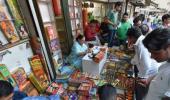Sivakasi is fighting for survival, thanks to the ban on firecrackers in Delhi, regulations in several other cities, pandemic-imposed sales dips, the ban on the use of barium nitrate...

Impressed by its industrial vibrancy, then prime minister Jawaharlal Nehru affectionately referred to this small city in Tamil Nadu as 'Kutty Japan' (Kutty means 'mini' in Tamil).
Now, in 2024, Nehru's Kutty Japan, popularly known as Sivakasi, still contributes to over 85 per cent of the fireworks made in the country, lighting up the festive colours of every city and village in India.
Despite this status, this small city is fighting for survival, thanks to the ban on firecrackers in Delhi, regulations in several other cities, pandemic-imposed sales dips, the ban on the use of barium nitrate as well as the manufacturing and selling of joined firecrackers.
Although Diwali sales are showing better numbers than last year, production in the organised sector is down, and sales have yet to return to pre-pandemic levels due to these challenges, say industry sources.
The Delhi Pollution Control Committee issued a complete ban on all kinds of firecrackers ahead of Diwali, although the Supreme Court allowed green crackers.
This ban will be imposed until January 1, 2025, across the National Capital Territory of Delhi.
The decision was termed a step to curb rising air pollution during the Diwali season in Delhi.
"The demand has yet to return to pre-pandemic levels. However, it is slowly getting back to normal. All the regulations and the ban in Delhi are having a huge impact on the industry," said S Sriram Ashok, president of The Indian Fireworks Manufacturers' Association (TIFMA).
The rising prices of raw materials like aluminium, sulphur and paper products have also affected companies here.
In Sivakasi, the industry reportedly provides jobs to around 300,000 people directly and another 500,000 indirectly.
The ban on barium has affected the production of key items like sparklers, chakris, anars, twinkling stars, and pencils.
"Production is down because of illegal manufacturers. A lot of illegal manufacturers are mushrooming due to the joint cracker regulations. Organised companies are not making them," said Murali Asaithambi of the Sivakasi Fireworks Manufacturers Association.
T Kannan, general secretary, TIFMA, echoed this sentiment: "Demand is there, but production in the organised sector is down by 15 per cent.
"Illegal manufacturers are gaining a lot of momentum," Kannan added.
According to a report by CARE Ratings, quoting the Tamil Nadu Fireworks & Amorces Manufacturers Association, the industry size was around Rs 3,000 crore (Rs 30 billion) prior to the pandemic, with the largest player, Standard Fireworks (SFPL), holding a 5 per cent market share, reflecting the highly unorganised nature of the industry.
'A significant part of the industry remains unorganised and operates like a cottage industry, with most of the work being done by hand in small sheds or at home,' the report stated.
'Moreover, competition from the unorganised sector, due to low entry barriers, environmental issues related to noise and air pollution, and the hazardous nature of the industry, pose challenges to the operations of companies like SFPL,' the report added.
'There have been instances of bans on the sales of cracker in the country over the past three years,' the report added.
"We cannot do anything regarding government regulations. Firecracker are not even among the top polluter in Delhi. Industry and traffic are the most polluting sector in the city," Kannan said.
Based on TIFMA estimates, there are around 1,175 firecracker manufacturers in the Virudhunagar district of Tamil Nadu, which includes Sivakasi.
If the government does not intervene, the industry may soon become a casualty of these regulations.
Feature Presentation: Ashish Narsale/Rediff.com











